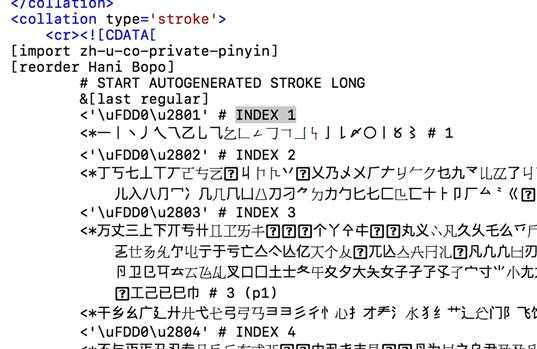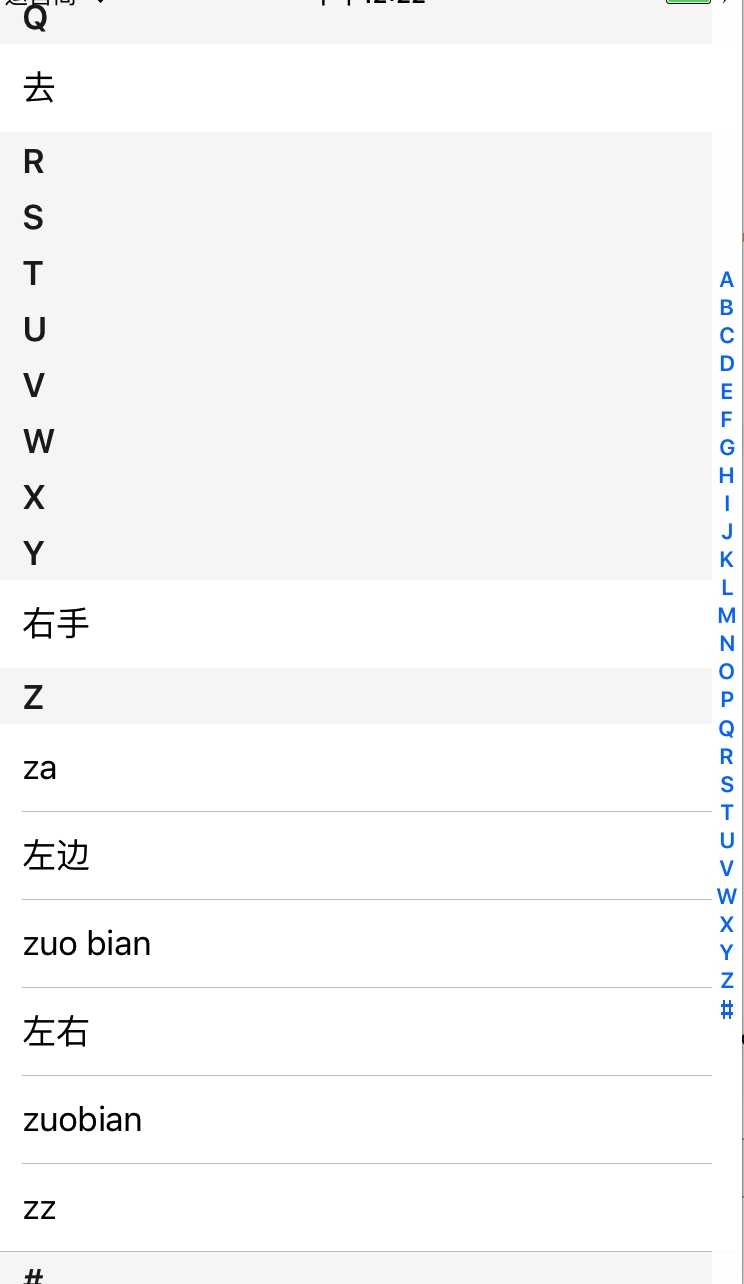标签:不同 简体 ntc key 例子 繁体 self 苹果 指定
在通讯录中,我们有很多联系人,需要把这些联系人进行索引。对于每一个索引项对应的若干字符串,需要对这些字符串进行排序。
需要解决两个问题:
我们已经知道了问题 2 的解决方案,即 UCA + CLDR。 下面我们来解决问题 1。
Unicode 指出了某个语言的索引项以及如何对某个字符进行索引。
这个看来不是问题,肯定是 A-Z 嘛。然而并不是这样子,因为不同的语言对应的索引项不同的,同一个语言不同排序方式对应的索引项也是不同的。在common/main中,指定了语言对应的索引项。
 ?
?
如上图所示,中文的索引是A-Z,而“标准摩洛哥塔马塞特文 (zgh)”的索引字母是? ? ? ? ? ? ? ? ? ? ? ? ? ? ? ? ? ? ? ? ? ? ? ? ? ? ? ? ? ? ?。
collation/zh.xml中的内容查看规则。 ?
? ?
?The UILocalizedIndexedCollation class is a convenience for organizing, sorting, and localizing the data for a table view that has a section index. The table view’s data source then uses the collation object to provide the table view with input for section titles and section index titles.
UILocationdIndexedCollation 是苹果给出的API,专门用于 tableview 的排序、索引和本地化。下面我们通过一个例子来说明如何使用。
根据苹果文档,首先必须指定支持的地区才能正确使用这个类。
your application bundle must properly declare support for the languages you want UILocalizedIndexedCollation to support. You can add localizations to your application bundle either by adding the appropriate .lproj folders, or by specifying supported localizations in your CFBundleLocalizations key in your application's info.plist file.
文档中指出了两种方法,我们使用第二种,在info.plist文件中加入相应的key。
 ?
?
// Get the current collation and keep a reference to it.
self.collation = [UILocalizedIndexedCollation currentCollation];
NSLog(@" section title is :%@",self.collation.sectionTitles);
当本机的语言首选项不同时,得到的sectionTitles也不同。默认语言是“简体中文”时,输出如下:
section title is :(
A,
B,
C,
D,
E,
F,
G,
H,
I,
J,
K,
L,
M,
N,
O,
P,
Q,
R,
S,
T,
U,
V,
W,
X,
Y,
Z,
"#")
默认语言是“繁体中文(香港)”时,输出如下:
section title is :(
1 畫,
2 畫,
3 畫,
4 畫,
5 畫,
6 畫,
7 畫,
8 畫,
9 畫,
10 畫,
11 畫,
12 畫,
13 畫,
14 畫,
15 畫,
16 畫,
17 畫,
18 畫,
19 畫,
20 畫,
21 畫,
22 畫,
23 畫,
24 畫,
25 畫以上,
A,
B,
C,
D,
E,
F,
G,
H,
I,
J,
K,
L,
M,
N,
O,
P,
Q,
R,
S,
T,
U,
V,
W,
X,
Y,
Z,
"#")
for (NSString *str in self.allStrings) {
// Ask the collation which section number the str belongs in, based on its locale name.
NSInteger sectionNumber = [self.collation sectionForObject:str collationStringSelector:@selector(description)];
NSMutableArray *sectionStrs = newSectionsArray[sectionNumber];
// Add the str to the section.
[sectionStrs addObject:str];
}
这里的关键是下面这个函数
- (NSInteger)sectionForObject:(id)object collationStringSelector:(SEL)selector;
selector 是一个方法,返回字符串,被UILocalizedIndexedCollation实例用于判断应该把obj放到第几个section,即第几个索引项。
// Now that all the data's in place, each section array needs to be sorted.
for (index = 0; index < sectionTitlesCount; index++) {
NSMutableArray *strArrayForSection = newSectionsArray[index];
// If the table view or its contents were editable, you would make a mutable copy here.
NSArray *sortedStrArrayForSection = [self.collation sortedArrayFromArray:strArrayForSection collationStringSelector:@selector(description)];
// Replace the existing array with the sorted array.
newSectionsArray[index] = sortedStrArrayForSection;
}
这里的关键是下面这个函数
- (NSArray *)sortedArrayFromArray:(NSArray *)array collationStringSelector:(SEL)selector;
array 中的每一个对象执行selector方法,返回一个字符串。所有的字符串排序时候的结果就是在这个 section 中的顺序,这里排序方法加入了地区信息。当然也可以使用自定义的排序方法,只要最后得到每一个 section 中所有对象的顺序就可以了。
 ?
?
从图中我们可以看出几个特点:
za < 左边左边 对应拼音是zuo bian,za < zuo。左边 <zuo bianzuo bian < 左右zuo bian < zuo you,即bian < you。左右 < zuobianzuo you < zuobian。 因为空格小于任何一个字母。其他语言是如何对应到索引项A-Z的呢?比如μ
标签:不同 简体 ntc key 例子 繁体 self 苹果 指定
原文地址:http://www.cnblogs.com/huahuahu/p/Unicode-zi-fu-chuan-suo-yin.html